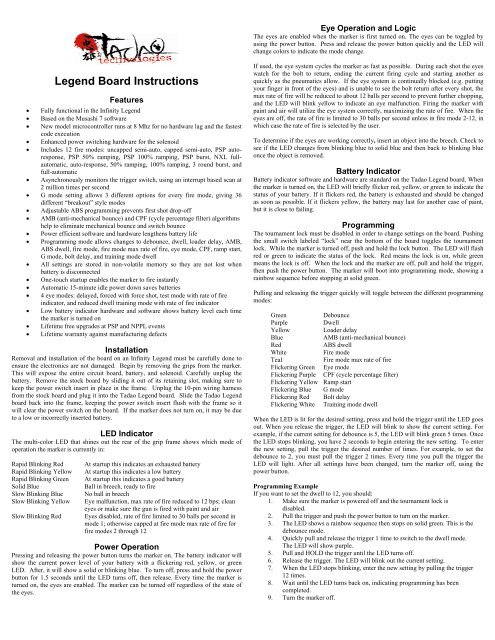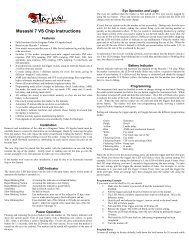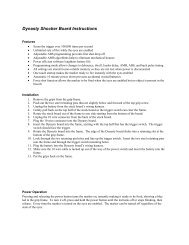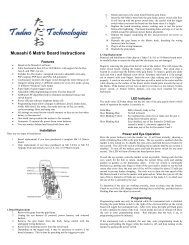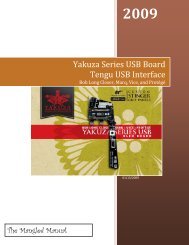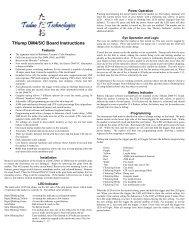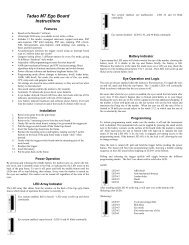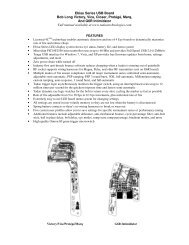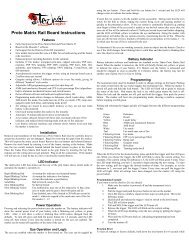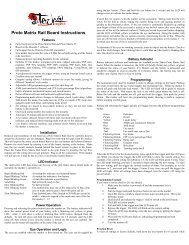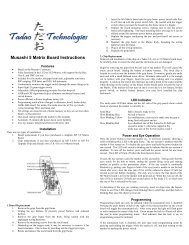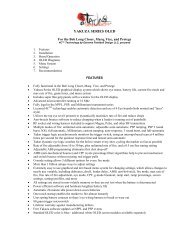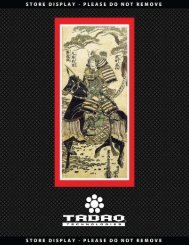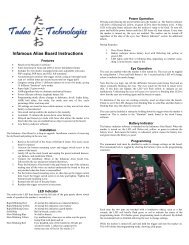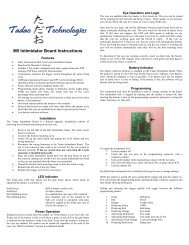Infinity Legend Board - Tadao Technologies
Infinity Legend Board - Tadao Technologies
Infinity Legend Board - Tadao Technologies
You also want an ePaper? Increase the reach of your titles
YUMPU automatically turns print PDFs into web optimized ePapers that Google loves.
Eye Operation and Logic<br />
The eyes are enabled when the marker is first turned on. The eyes can be toggled by<br />
using the power button. Press and release the power button quickly and the LED will<br />
change colors to indicate the mode change.<br />
<strong>Legend</strong> <strong>Board</strong> Instructions<br />
Features<br />
• Fully functional in the <strong>Infinity</strong> <strong>Legend</strong><br />
• Based on the Musashi 7 software<br />
• New model microcontroller runs at 8 Mhz for no hardware lag and the fastest<br />
code execution<br />
• Enhanced power switching hardware for the solenoid<br />
• Includes 12 fire modes: uncapped semi-auto, capped semi-auto, PSP autoresponse,<br />
PSP 50% ramping, PSP 100% ramping, PSP burst, NXL fullautomatic,<br />
auto-response, 50% ramping, 100% ramping, 3 round burst, and<br />
full-automatic<br />
• Asynchronously monitors the trigger switch, using an interrupt based scan at<br />
2 million times per second<br />
• G mode setting allows 3 different options for every fire mode, giving 36<br />
different “breakout” style modes<br />
• Adjustable ABS programming prevents first shot drop-off<br />
• AMB (anti-mechanical bounce) and CPF (cycle percentage filter) algorithms<br />
help to eliminate mechanical bounce and switch bounce<br />
• Power efficient software and hardware lengthens battery life<br />
• Programming mode allows changes to debounce, dwell, loader delay, AMB,<br />
ABS dwell, fire mode, fire mode max rate of fire, eye mode, CPF, ramp start,<br />
G mode, bolt delay, and training mode dwell<br />
• All settings are stored in non-volatile memory so they are not lost when<br />
battery is disconnected<br />
• One-touch startup enables the marker to fire instantly<br />
• Automatic 15-minute idle power down saves batteries<br />
• 4 eye modes: delayed, forced with force shot, test mode with rate of fire<br />
indicator, and reduced dwell training mode with rate of fire indicator<br />
• Low battery indicator hardware and software shows battery level each time<br />
the marker is turned on<br />
• Lifetime free upgrades at PSP and NPPL events<br />
• Lifetime warranty against manufacturing defects<br />
Installation<br />
Removal and installation of the board on an <strong>Infinity</strong> <strong>Legend</strong> must be carefully done to<br />
ensure the electronics are not damaged. Begin by removing the grips from the marker.<br />
This will expose the entire circuit board, battery, and solenoid. Carefully unplug the<br />
battery. Remove the stock board by sliding it out of its retaining slot, making sure to<br />
keep the power switch insert in place in the frame. Unplug the 10-pin wiring harness<br />
from the stock board and plug it into the <strong>Tadao</strong> <strong>Legend</strong> board. Slide the <strong>Tadao</strong> <strong>Legend</strong><br />
board back into the frame, keeping the power switch insert flush with the frame so it<br />
will clear the power switch on the board. If the marker does not turn on, it may be due<br />
to a low or incorrectly inserted battery.<br />
LED Indicator<br />
The multi-color LED that shines out the rear of the grip frame shows which mode of<br />
operation the marker is currently in:<br />
Rapid Blinking Red<br />
Rapid Blinking Yellow<br />
Rapid Blinking Green<br />
Solid Blue<br />
Slow Blinking Blue<br />
Slow Blinking Yellow<br />
Slow Blinking Red<br />
At startup this indicates an exhausted battery<br />
At startup this indicates a low battery<br />
At startup this indicates a good battery<br />
Ball in breech, ready to fire<br />
No ball in breech<br />
Eye malfunction, max rate of fire reduced to 12 bps; clean<br />
eyes or make sure the gun is fired with paint and air<br />
Eyes disabled, rate of fire limited to 30 balls per second in<br />
mode 1; otherwise capped at fire mode max rate of fire for<br />
fire modes 2 through 12<br />
Power Operation<br />
Pressing and releasing the power button turns the marker on. The battery indicator will<br />
show the current power level of your battery with a flickering red, yellow, or green<br />
LED. After, it will show a solid or blinking blue. To turn off, press and hold the power<br />
button for 1.5 seconds until the LED turns off, then release. Every time the marker is<br />
turned on, the eyes are enabled. The marker can be turned off regardless of the state of<br />
the eyes.<br />
If used, the eye system cycles the marker as fast as possible. During each shot the eyes<br />
watch for the bolt to return, ending the current firing cycle and starting another as<br />
quickly as the pneumatics allow. If the eye system is continually blocked (e.g. putting<br />
your finger in front of the eyes) and is unable to see the bolt return after every shot, the<br />
max rate of fire will be reduced to about 12 balls per second to prevent further chopping,<br />
and the LED will blink yellow to indicate an eye malfunction. Firing the marker with<br />
paint and air will utilize the eye system correctly, maximizing the rate of fire. When the<br />
eyes are off, the rate of fire is limited to 30 balls per second unless in fire mode 2-12, in<br />
which case the rate of fire is selected by the user.<br />
To determine if the eyes are working correctly, insert an object into the breech. Check to<br />
see if the LED changes from blinking blue to solid blue and then back to blinking blue<br />
once the object is removed.<br />
Battery Indicator<br />
Battery indicator software and hardware are standard on the <strong>Tadao</strong> <strong>Legend</strong> board. When<br />
the marker is turned on, the LED will briefly flicker red, yellow, or green to indicate the<br />
status of your battery. If it flickers red, the battery is exhausted and should be changed<br />
as soon as possible. If it flickers yellow, the battery may last for another case of paint,<br />
but it is close to failing.<br />
Programming<br />
The tournament lock must be disabled in order to change settings on the board. Pushing<br />
the small switch labeled “lock” near the bottom of the board toggles the tournament<br />
lock. While the marker is turned off, push and hold the lock button. The LED will flash<br />
red or green to indicate the status of the lock. Red means the lock is on, while green<br />
means the lock is off. When the lock and the marker are off, pull and hold the trigger,<br />
then push the power button. The marker will boot into programming mode, showing a<br />
rainbow sequence before stopping at solid green.<br />
Pulling and releasing the trigger quickly will toggle between the different programming<br />
modes:<br />
Green<br />
Debounce<br />
Purple<br />
Dwell<br />
Yellow<br />
Loader delay<br />
Blue<br />
AMB (anti-mechanical bounce)<br />
Red<br />
ABS dwell<br />
White<br />
Fire mode<br />
Teal<br />
Fire mode max rate of fire<br />
Flickering Green Eye mode<br />
Flickering Purple CPF (cycle percentage filter)<br />
Flickering Yellow Ramp start<br />
Flickering Blue G mode<br />
Flickering Red Bolt delay<br />
Flickering White Training mode dwell<br />
When the LED is lit for the desired setting, press and hold the trigger until the LED goes<br />
out. When you release the trigger, the LED will blink to show the current setting. For<br />
example, if the current setting for debounce is 5, the LED will blink green 5 times. Once<br />
the LED stops blinking, you have 2 seconds to begin entering the new setting. To enter<br />
the new setting, pull the trigger the desired number of times. For example, to set the<br />
debounce to 2, you must pull the trigger 2 times. Every time you pull the trigger the<br />
LED will light. After all settings have been changed, turn the marker off, using the<br />
power button.<br />
Programming Example<br />
If you want to set the dwell to 12, you should:<br />
1. Make sure the marker is powered off and the tournament lock is<br />
disabled.<br />
2. Pull the trigger and push the power button to turn on the marker.<br />
3. The LED shows a rainbow sequence then stops on solid green. This is the<br />
debounce mode.<br />
4. Quickly pull and release the trigger 1 time to switch to the dwell mode.<br />
The LED will show purple.<br />
5. Pull and HOLD the trigger until the LED turns off.<br />
6. Release the trigger. The LED will blink out the current setting.<br />
7. When the LED stops blinking, enter the new setting by pulling the trigger<br />
12 times.<br />
8. Wait until the LED turns back on, indicating programming has been<br />
completed.<br />
9. Turn the marker off.
Program Reset<br />
To reset all settings to factory defaults, hold down the lock button for 10 seconds while<br />
in programming mode. The LED will rapidly cycle through every setting color to<br />
indicate that the process has completed.<br />
Settings<br />
Debounce – The <strong>Tadao</strong> <strong>Legend</strong> board features an interrupt based debounce algorithm<br />
that effectively “scans” the trigger over 2 million times per second. It runs this<br />
completely independent of code execution on the microcontroller so your trigger pulls<br />
are always registered. The debounce setting is in increments of 1/2 milliseconds. Users<br />
should be aware that low debounce settings may cause the marker to read switch bounce<br />
as additional pulls, falsely generating shots or near full-automatic fire. The setting<br />
ranges from 1 to 50 and is defaulted at 10 (5 ms).<br />
Dwell – The amount of time the solenoid is energized each time the marker is fired. The<br />
default is 10 ms. The range is 2 to 20 ms. Too low of a dwell may lead to inconsistency<br />
or drop-off. Too high of a dwell can cause bad air efficiency.<br />
Loader delay – Adds a slight delay after the eye has seen a ball and the bolt is cycled,<br />
causing the gun to fire. If not using force fed loaders, it may be necessary to increase<br />
this setting to prevent chopping. A setting of 1 means no loader delay, which is the<br />
fastest. The default is 2 and may be set from 1 to 10.<br />
AMB (Anti-mechanical bounce) – Allows the user to adjust the anti-mechanical<br />
bounce feature. Mechanical bounce occurs due to the kick generated during each shot<br />
and can cause the marker to “run away” on the first few shots. AMB helps stop markers<br />
from going full-auto when the trigger is pulled very slowly. The default is 2 and may be<br />
set from 1 to 5 (1 being off). AMB is only used in fire modes 1 and 2 (semi-automatic<br />
unlimited and adjustable).<br />
ABS dwell – Amount of dwell time added for an ABS (anti-bolt stick) shot. The range<br />
is from 1 to 10 additional milliseconds of dwell. The default is 1, which is disabled.<br />
ABS programming helps to eliminate first shot drop-off. First shot drop-off occurs when<br />
the lube and o-rings settle or “stick” inside the marker after it has been sitting. The next<br />
shot fired will be lower in velocity because the bolt has to break free. ABS will slightly<br />
increase the dwell to compensate if the marker is left sitting for 15 seconds.<br />
Fire mode – Included are 12 different fire modes (default is 1):<br />
1. Semi-automatic, unlimited rate of fire<br />
2. Semi-automatic, adjustable rate of fire<br />
3. PSP auto-response<br />
4. PSP 50% ramping, adjustable ramp start<br />
5. PSP 100% ramping, adjustable ramp start<br />
6. PSP burst<br />
7. NXL full-automatic<br />
8. Auto-response<br />
9. 50% ramping<br />
10. 100% ramping<br />
11. 3 round burst<br />
12. Full-automatic<br />
Setting 1 is normal semi-automatic with an unlimited rate of fire while the eyes are<br />
enabled. When the eyes are turned off, the max rate of fire is set to 30 balls per second.<br />
Setting 2 is semi-automatic with an adjustable rate of fire. It limits the maximum balls<br />
per second that can be fired. The cap is set by the max rate of fire setting.<br />
Setting 3 is the PSP auto-response fire mode that works as follows:<br />
• The first 3 shots of a string are semi-automatic<br />
• After the 4th shot the marker will fire on the pull and release in autoresponse<br />
mode<br />
• If the user stops firing for more than 1 second, the 3-shot semi-automatic<br />
count starts over<br />
Setting 4 is the PSP 50% ramping fire mode that works as follows:<br />
• The first 3 shots of a string are semi-automatic<br />
• After the 4th shot the marker will ramp, adding 1 additional shot for every 2<br />
pulled by the user, as long as the user pulls the trigger faster than the ramp<br />
start setting<br />
• If the user stops firing for more than 1 second, the 3-shot semi-automatic<br />
count starts over<br />
Setting 5 is the PSP 100% ramping fire mode that works as follows:<br />
• The first 3 shots of a string are semi-automatic<br />
• After the 4th shot the marker will ramp up to the loader’s maximum speed or<br />
the maximum rate of fire, as long as the user pulls the trigger faster than the<br />
ramp start setting<br />
• If the user stops firing for more than 1 second, the 3-shot semi-automatic<br />
count starts over<br />
Setting 6 is the PSP burst fire mode that works as follows:<br />
• The first 3 shots of a string are semi-automatic<br />
• After the 4th shot the marker will burst fire 3 shots per pull<br />
• If the user stops firing for more than 1 second, the 3-shot semi-automatic<br />
count starts over<br />
Setting 7 is the NXL full-automatic fire mode. It functions similarly to the PSP fire<br />
modes except, after the 3rd semi-automatic shot, the user may pull and hold the trigger<br />
for the marker to fire in full-automatic.<br />
Setting 8 is the normal auto-response fire mode. The marker will fire on each pull and<br />
release of the trigger, generating 2 shots per full pull cycle.<br />
Setting 9 is the normal 50% ramping fire mode. The marker will fire in semi-automatic<br />
unless the user pulls the trigger faster than the ramp start setting. Once the ramp start<br />
setting has been achieved, the marker will 50% ramp, adding 1 additional shot for every<br />
2 trigger pulls.<br />
Setting 10 is the normal 100% ramping fire mode. The marker will fire in semiautomatic<br />
unless the user pulls the trigger faster than the ramp start setting. Once the<br />
ramp start setting has been achieved, the marker will ramp up to the maximum feed rate<br />
of the loader or the maximum rate of fire setting, whichever is lower.<br />
Setting 11 is the normal 3 round burst fire mode. The marker will burst fire 3 times for<br />
every pull and release of the trigger.<br />
Setting 12 is the normal full-automatic fire mode. As long as the trigger is depressed the<br />
marker will fire in full-automatic.<br />
Fire mode max rate of fire – The max rate of fire setting applies to the 2nd – 12th fire<br />
modes. The max rate of fire is adjustable from 10 to 25 balls per second, and has an<br />
unlimited setting for maxing out the loader system. The default is 7, which is roughly<br />
13 balls per second. Oscillator inconsistencies from chip to chip make it impossible to<br />
time perfectly, so the only true way to check rate of fire is to use a Pact Timer or<br />
ballistic chronograph. The red radar chronographs commonly found at fields are NOT<br />
reliable.<br />
Setting BPS Setting BPS<br />
1 10.0 12 15.5<br />
2 10.5 13 16.0<br />
3 11.0 14 17.0<br />
4 11.5 15 18.0<br />
5 12.0 16 19.0<br />
6 12.5 17 20.0<br />
7 (default) 13.0 18 21.0<br />
8 13.5 19 22.0<br />
9 14.0 20 23.0<br />
10 14.5 21 24.0<br />
11 15.0 22 Unlimited eyes on, 25.0 bps eyes off<br />
Eye Mode – Four eye modes are available:<br />
1. Delayed – If the eye system does not detect a ball in the breech for 1/2 second, the<br />
marker automatically fires. This is useful for sound activated loaders because it<br />
ensures that a shot is fired, even without paint, so the loader will continue to feed.<br />
2. Forced with force shot – The marker only fires if paint is seen in the breech or the<br />
user pulls and holds the trigger for 1/2 second, thereby initiating a force shot.<br />
3. Test – This mode is specifically used to see how fast the user can fire the marker,<br />
or how fast the pneumatics can actually cycle. The eyes work to prevent firing if<br />
they are blocked. This mode is only for dry firing. The LED shows the fastest<br />
achieved rate of fire:<br />
Red less than 10 bps<br />
Yellow between 10 and 15 bps<br />
Green between 15 and 20 bps<br />
Blue between 20 and 25 bps<br />
White 25 bps or greater<br />
As long as the user continues to fire, the fastest achieved rate of fire will continue<br />
to be displayed on the LED. If the user stops firing for 1 second, the LED will<br />
cycle back through the rate of fire colors.<br />
4. Training – This mode works just like the test eye mode, but features an adjustable
dwell setting independent of the normal dwell, making it easy for users to adjust their<br />
trigger settings and try them out with much less noise and air consumption. The<br />
training mode dwell setting corresponds with this eye mode.<br />
Note: The test and training eye modes work with any fire mode selected. The fire mode<br />
max rate of fire is set to unlimited while in test or training eye mode.<br />
CPF (Cycle percentage filter) – The cycle percentage filter allows adjustment of the<br />
point within the current firing cycle that a new buffered shot is allowed. Almost all<br />
electronic paintball markers allow a single shot to be buffered in the event the user is<br />
fast enough to release the trigger and pull again during the current firing cycle. The<br />
CPF setting is adjustable from 1 to 10. Setting 1 turns the CPF off, allowing buffered<br />
shots at any point in the firing cycle. Settings 2 through 10 set the percentage of the<br />
firing cycle that must pass before shots may be buffered:<br />
1. CPF turned off<br />
2. 10% of the firing cycle must pass before a buffered shot is allowed<br />
3. 20%<br />
4. 30%<br />
5. 40%<br />
6. 50%<br />
7. 60%<br />
8. 70%<br />
9. 80%<br />
10. 90%<br />
A higher CPF setting results in less unintentional bounce. For instance, it is possible<br />
that if your debounce setting is border line, you can fire the marker a few times, then<br />
hold it loosely and allow it to brush against your finger, going full-automatic. Since<br />
most switch bounce from either a low debounce setting or mechanical bounce occurs<br />
almost immediately after the trigger is released, CPF can be very effective in eliminating<br />
falsely generated trigger activity.<br />
Ramp start – This setting is only used for the four ramping fire modes (PSP 50% and<br />
100% ramping, and normal 50% and 100% ramping). It sets the minimum pulls per<br />
second that must be maintained for the software to add shots or ramp up to the<br />
maximum rate of fire setting. The default is 5 and is adjustable from 4 to 14 pulls per<br />
second.<br />
G mode – The <strong>Tadao</strong> <strong>Legend</strong> board includes a special mode that can be applied 3<br />
different ways to each of the 12 fire modes, giving 36 “breakout” style combinations. G<br />
mode gives the user full-automatic with an unlimited rate of fire for a single pull, for use<br />
at the start of the game. The setting is defaulted at 4, which turns G mode off. Settings<br />
1, 2, and 3 dictate at which pull that G mode will become active. If set to 1, the first<br />
shot after you turn on the marker will be full-automatic with an unlimited rate of fire for<br />
as long as you hold down the trigger. As soon as you release the trigger, the marker will<br />
stop shooting and default back to your selected fire mode. If set to 3, the G mode will<br />
be active on the third shot after the marker is turned on. Regardless of the fire mode<br />
selected, the shots before the G mode will be semi-automatic. G mode can only be used<br />
once for each time the marker is turned on.<br />
Note: G mode is illegal for use in all tournament series. <strong>Tadao</strong> <strong>Technologies</strong> LLC<br />
takes no responsibility for the user’s choice in using G mode.<br />
Bolt delay – This setting determines how long the eyes are ignored after the dwell time<br />
ends. Some delay is necessary to allow the bolt to get far enough forward so the eye<br />
system does not mistake a small gap between a paintball and the bolt face for a bolt<br />
return. The default is 10 ms and may be set from 1 to 15 ms. Higher settings will reduce<br />
the maximum capable rate of fire, while lower settings may lead to skipped or blank<br />
shots because the bolt does not have enough time to block the eyes on its forward stroke.<br />
Training mode dwell – This setting selects the marker’s dwell time if using the training<br />
eye mode (eye mode set to 4). The dwell time is reduced so that the marker barely<br />
cycles, consuming less air and emitting less noise so users can train their finger speed.<br />
The setting is adjustable from 1 to 10 ms, and is defaulted at 3 ms. If this setting is too<br />
high, the marker may actually fire. If that is your intention, you should switch to the test<br />
eye mode, which uses the normal dwell setting.<br />
and operation will continue as normal.<br />
A tip for setting the debounce, AMB, and CPF – This only applies to semi-automatic<br />
fire modes (modes 1 and 2) since AMB is disabled in the PSP fire modes or NXL mode.<br />
Debounce, AMB, CPF setup steps, while using paint and air:<br />
1. Turn AMB and CPF off (set both to 1).<br />
2. Starting at debounce 1-3, raise the debounce setting a notch at a time until<br />
excessive trigger bounce goes away. The goal is to have one pull, one shot,<br />
regardless of rate of fire. Do NOT slow pull test for bounce during this phase.<br />
Instead, pull the trigger rapidly or walk it, listening for double or triple fires.<br />
3. When it appears that it is only one shot, one pull for solid trigger pulls, try the<br />
slow pull test. Holding the marker steady, slowly pull the trigger and see if<br />
multiple shots can be generated from the single pull.<br />
4. Increase the CPF setting a notch at a time until the slow pull bounce starts to<br />
disappear. An additional test is to fire a few rounds quickly, then hold the trigger<br />
right on the activation point to see if the marker will run away.<br />
5. If you reach setting 10 with CPF and the marker can still be slow pulled to fire<br />
full-automatic, your debounce setting is probably too low. Go back to step 2.<br />
6. AMB should not be set above 3, if possible, since it is not as transparent to the<br />
user as CPF. Even a CPF setting of 10 will not be noticed by the user.<br />
Example Setting Profiles:<br />
1. Tournament legal semi-automatic (NPPL)<br />
a. Fire mode 1 or 2 (semi-auto unlimited or capped)<br />
b. Debounce 5-20<br />
c. AMB 2<br />
d. CPF 2-5<br />
e. Loader delay set to match your loader (1-4 for Halo, 4-10 for gravity feed)<br />
2. PSP X-Ball, CFOA<br />
a. Fire mode 3, 4, 5, or 6<br />
b. Max rate of fire set to 4-6, depending on Pact Timer readings<br />
c. Debounce 5-20<br />
d. Ramp start 5 or higher if using PSP 50% or 100% ramping<br />
e. Loader delay set to match your loader (1-4 for Halo, 4-10 for gravity feed)<br />
3. Millennium<br />
a. Fire mode 4, 5, 9, or 10 (PSP or normal ramping modes)<br />
b. Max rate of fire set to 4-6, depending on Pact Timer readings<br />
c. Debounce 5-20<br />
d. Ramp start 8 or higher<br />
e. Loader delay set to match your loader (1-4 for Halo, 4-10 for gravity feed)<br />
4. NXL<br />
a. Fire mode 7 (NXL full-automatic)<br />
b. Max rate of fire set to 4-6, depending on Pact Timer readings<br />
c. Debounce 5-20<br />
d. Loader delay set to match your loader (1-4 for Halo, 4-10 for gravity feed)<br />
5. Ludicrous Speed (absolute fastest/bounciest)<br />
a. Any fire mode<br />
b. Max rate of fire set to 26 (unlimited)<br />
c. Debounce 1<br />
d. AMB 1 if using semi-automatic<br />
e. CPF 1<br />
f. Ramp start 4 if using any ramping modes<br />
g. Loader delay<br />
Additional Information<br />
www.tadaotechnologies.com<br />
Additional Features<br />
RF transmitter socket and harness – Included with your board is a wiring harness that<br />
allows plug and play installation of an RF based loader, such as the Draxxus Pulse. The<br />
wiring harness plugs into the RF socket on the board and into the RF transmitter.<br />
When installed and synchronized with the loader, the transmitter will be automatically<br />
powered during every shot.<br />
Force Shot – In the event the eyes are enabled, the breech is empty, and the user wants<br />
to fire a clearing shot, a force shot can be initiated by pulling and holding the trigger for<br />
1/2 second. This is useful with force fed loaders that sometimes push a ball slightly into<br />
the detents where the eyes are unable to see it. After force firing, the next ball will load,


